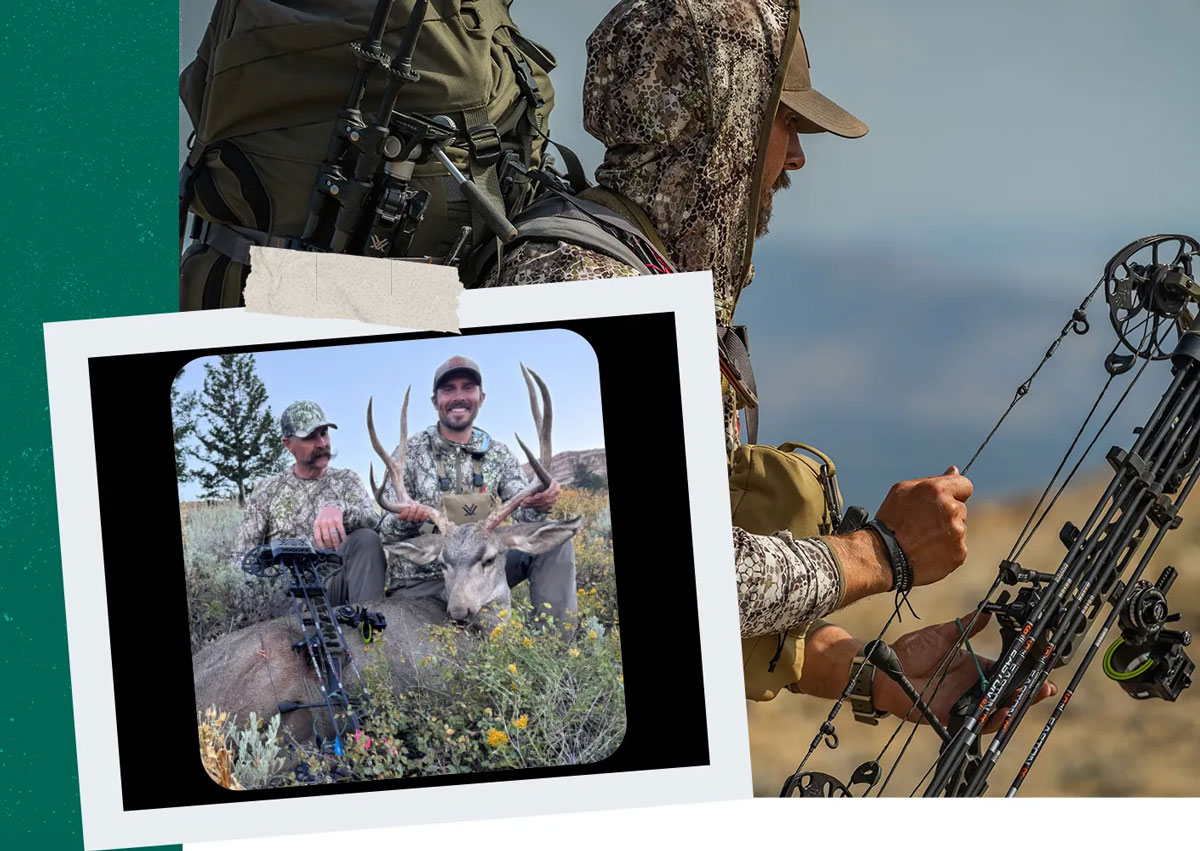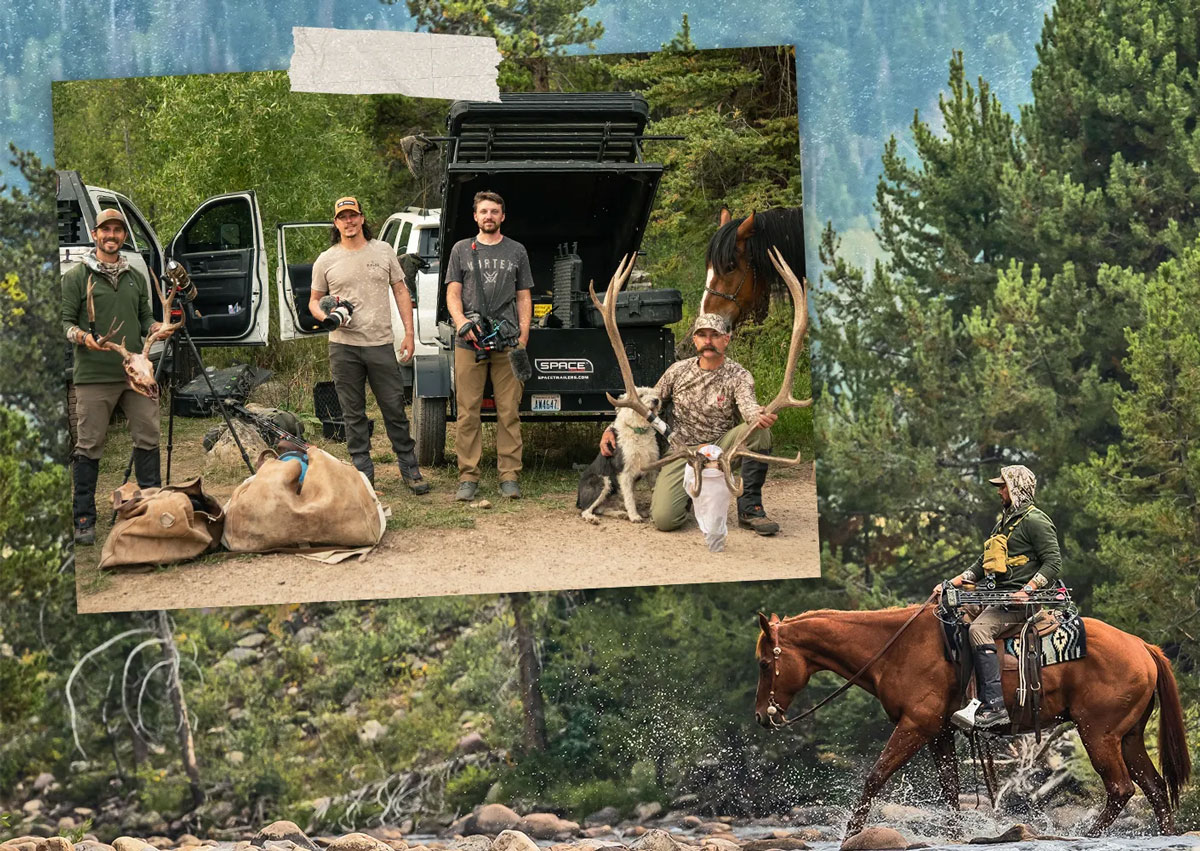The Other Side of the Camera
For the first time, he's trying to harvest a deer with a bow. And for the first time, he's on the other side of the camera.

For a man who started his career as a Hollywood architect designing custom homes for A-List celebs, it’s odd there’s no place Clint Easley would rather be than here, in the dust and dirt. Standing stock still in middle-of-nowhere Utah.
Now an outdoor television producer, cameraman, and photographer, he can’t be farther from the glitz and glamor of Tinseltown, or the comfort of the blueprints he’d spent years drawing. His heart thundering in his ears, buried in a tree’s shade, taking deep, steadying breaths as the mule deer buck steps into the open.
An unlikely career path led him to this unlikely hunt. For the last 15 years, after cashing in his career as an architect, he’s filmed hundreds of hunts for big names and unknowns alike. An antelope hunt for Guy Fieri. An Alaskan brown bear hunt for the leadership at Black Rifle Coffee Company.
But this hunt is different; it’s a hunt of firsts. For the first time, he’s trying to harvest a deer with a bow. And for the first time, he’s on the other side of the camera.
And it’s a feeling unlike anything he’s ever known.

The blueprint
“There’s definitely pressure when you’re filming,” Clint said. “I filmed a big horn sheep hunt in Hell’s Canyon and that’s a $250,000 tag, so you better make sure you hit the record button and get it right. But it’s different when you’re the hunter. You have to make the shot count, and there’s the pressure where if you screw up, it’s on film.”
The desire to understand that feeling is a big reason he’s out here, in this basin with a hunter’s breeze in his face, slowly lifting his bow. Knowing the stakes, Clint and Tee Hover, his hunting partner, planned meticulously for this moment, building a complete blueprint for success. Two years to draw the tag, 13 days of scouting and glassing.
Hours spent perched on a rocky outcropping above, planning the stalk down to this very spot. Tee, filming from the outcropping, had even slipped Clint a pair of wool socks to put on when he got close to keep his footsteps quiet. Fool proof, no stone unturned.
“I look up, and Tee is giving hand signals. I thought he was telling me to move in closer to the buck. But what he was saying is there were actually two bucks,” Clint said. And one of them, the one now standing in the open, was walking his way. Just like that, the blueprint they’d so carefully created goes up in smoke.
Clint anchors just as the deer steps back behind a tree. 10 seconds at full draw, 20. 40 seconds pass and the emotion and adrenaline have his hand’s shaking, the bow turning tight figure eights.
His arms start to wobble so he slowly lets down. And of course, just then, the deer steps back out. Knowing from hunts he’d filmed that chances on mulie bucks don’t come frequently, Clint draws again, slowly. Releases, and the arrow flies high, skimming the buck’s back as the second buck spooks, crashing off.
“Both deer end up standing, one at 80 yards, the one I hit is in cover closer to me. Maybe two minutes go by and I’m feeling every emotion.” Clint said. “Then, the one in cover steps out just enough, 50 yards away. I get a good anchor, and I release the arrow.”

The Perfect Hunting Story
There’s an art to filming a hunting story, something Clint learned over years of trial and error. “Is this the person’s first hunt?” Clint said. “What’s unique or challenging about the terrain? There’s a lot of elements in any hunt you can pare down into a great story.”
The story to this hunt? Blueprints are better left on drafting tables. “Hunting is hunting,” Clint said. “There’s always going to be an organic story that develops. In every hunt, something unique happens, something you don’t expect.”
Shaking, trying to get his mind around a second chance he never expected, Clint stands in the sun. The consummate cameraman, he has a GoPro in his pocket and as the buck drops, he tries recording his emotions. But being on the other side of the camera, carefully scouting, stalking, and finally harvesting the buck, has changed him as a hunter.
“Outside of having a kid, it’s the best feeling I’ve ever had in my life,” Clint said. “You can’t explain that level of emotion until you’ve been there. And I get it now. Now I know why these guys are hardcore bowhunters. That feeling after a hunt like that? It’s impossible not to want to go back for more.”
Sure. It’s odd there’s nowhere this former Hollywood architect wants to be than smiling and spent in the Utah sun. As Tee cheers from above, Clint feels something in his pocket. He reaches back and finds the wool socks he was supposed to wear when he got close, the whole plan long since forgotten.
Watch Vortex® Hunts | Full-Send 40 to see the full hunt.
3 Quick tips for backcountry success
“Filming so frequently with guides, I got to develop an understanding of the hunt from their perspective,” Clint said. “I’m very lucky to have had the opportunity to pick up tips and tricks for all kinds of game from all over the world.” Here are three tips for your next hunt.
-
Use Your Rangefinder to Build a Bubble. Know the ranges of nearby objects so you can make good choices if an animal steps out and you can’t reach for your rangefinder. It’s simple, and it makes sure you stay connected to your environment.
-
The “Golf Bag” Approach. For serious hunters, having a collection of optics lets you build the right kit for any hunt. “If you’re hunting mule deer in a basin like I was, you want to have good, high-powered optics like 10x50s,” Clint said. “Whereas if you’re doing an archery hunt where you’re in close from the get-go, 8x32s will be much better. It’s always good to have a golf bag of optics to draw from.”
-
High Country Patience. “With high-country hunting, the challenge is there might be bucks, but you have to wait for that one buck to bed down in that one spot where the wind, the shade, and everything is just right,” Clint said. “You can’t rush that. It’s a very optics-heavy style of hunting. Lots of glassing before you think about stalking.”
Clint Easley is the Founder and CEO of REVOL Entertainment. He has filmed for Hollywood Hunter, Maverick, Hunt Masters, and many more. His work has appeared on Sportsman Channel, Outdoor Channel, Root Sports™, CBS, and Fox Nation. Bitten hard by the archery bug, he already has an elk tag for this fall.



